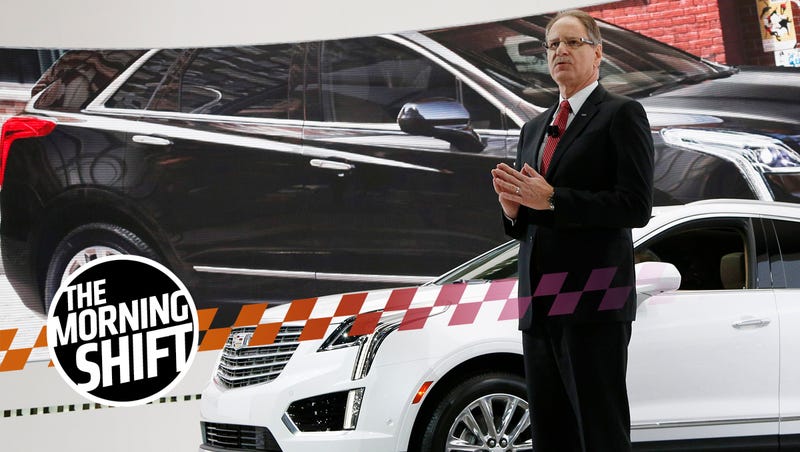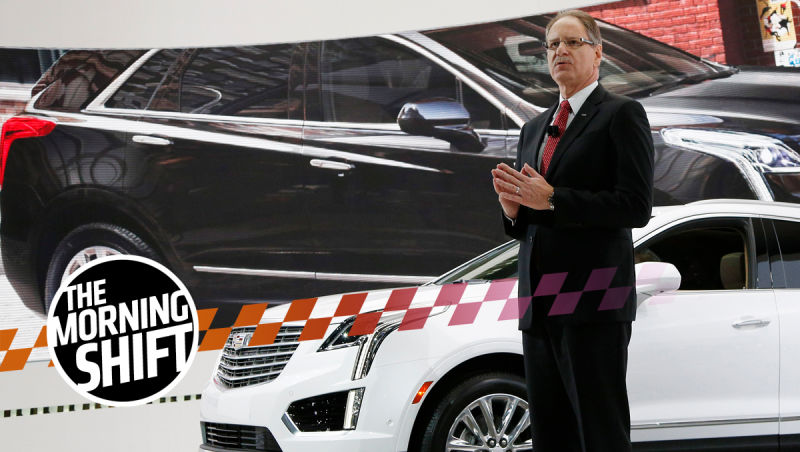
Good morning! Welcome to The Morning Shift, your roundup of the auto news you crave, all in one place every weekday morning. Here are the important stories you need to know.
1st Gear: Slow To Adapt?
News broke yesterday of Cadillac CEO Johan de Nysschen’s abrupt departure from the company. De Nysschen had been at the helm of Cadillac for just under four years and there are probably a lot of reasons General Motors decided to part ways with him, from a failed vehicle pricing strategy to soured relationships with dealers and slow sales. But a lack of SUVs in Cadillac’s sedan-heavy lineup apparently also played a big role.
The SUV and crossover-craze was long in full swing by the time Cadillac made any real moves to join the fray by adding the XT4 to its lineup, only the third SUV/crossover in its sedan-heavy offerings. GM wasn’t happy about that, according Bloomberg:
GM management wanted to see a greater effort to sell new models like the CT6 sedan and XT5 sport utility vehicle, said a person familiar with the matter. The XT5, which replaced the SRX in 2016, did little to improve demand with about 68,300 sales last year — no better than SRX sales in 2015, even though SUVs have been on a tear in the U.S.
The XT4, which debuted just last month at the New York Auto Show, comes at a time when Cadillac is already lagging far behind its German competitors, who are offering scores more SUV and crossover options than the American automaker.
Advertisement
And it showed in sales. Automotive News also reports that Cadillac’s annual U.S. sales have been been pretty shitty since de Nysschen’s first full year as CEO, declining 11 percent since 2015.
At least, writes Bloomberg, the brand is popular in China:
During de Nysschen’s nearly four-year tenure, Cadillac’s recovery efforts have been a mixed bag. Record global sales are expected this year largely due to China, where the brand has been among the fastest-growing in an expanding industry. The U.S. has been a different story — annual deliveries declined in all but one of the years under de Nysschen.
Advertisement
So, there’s that.
Cadillac’s new CEO will be Steve Carlisle, a longtime GM insider—and de Nysschen, a veteran of BMW, Audi and Infiniti, was very much the opposite. Where will Carlisle lead the brand? We’ll find out soon enough.
2nd Gear: A Lot Of People Are Asking Questions About That Safety Stat Tesla Keeps Pushing
Advertisement
In January of last year, the National Highway Traffic Safety Administration closed the investigation of a fatal 2016 crash involving a Tesla Model S and Autopilot and did not order Tesla to issue a recall of Autopilot. In that 13-page report, NHTSA wrote, “The data show that the Tesla vehicles crash rate dropped by almost 40 percent after Autosteer installation.”
Since then, both Tesla and Elon Musk have touted that 40 percent figure when advocating for the safety of its car. We reported on the statistic back in October 2017 because it was unclear exactly how and from where Tesla and NHTSA determined it because:
NHTSA’s investigation involved a review of data from model year 2014-2016 Model S and Model X vehicles equipped with Autopilot. The 40 percent claim is significant because most of the functions that make up the Autopilot suite—forward collision warning, automatic emergency braking, adaptive cruise control—are not unusual in newer cars on the road today.
Autosteer, however, is relatively unique to Tesla. That’s what makes singling out Autosteer as the source of a 40 percent drop so curious. Forward collision warning and automatic emergency braking were introduced just months before the introduction of Autosteer in October 2015. A previous IIHS study showsthat both the collision warning and auto emergency braking can deliver a similar reduction in crashes.
Advertisement
Spokespeople from both NHTSA and Tesla declined to comment.
Still, though, the concern over this “disputed crash stat” hasn’t gone away, according to Bloomberg in an excellent piece that elaborates on the issue. It spoke to a number of industry experts who are calling on the automaker and NHTSA to release the data, especially now that self-driving technology has been linked a several recent deaths.
From Bryant Walker Smith, a professor at the University of South Carolina’s School of Law who studies self-driving car regulations:
“If Tesla’s going to keep asserting that, and particularly if they’re going to keep crediting NHTSA for it, then I think they need to provide the necessary analysis, caveats and qualifications behind that number. If that is even close to being true, then that is one of the biggest safety advances since the seat belt.”
Advertisement
From Nidhi Kalra, a senior information scientist at Rand Corp. and a self-driving car researcher:
The statements are “an overly generous interpretation” of what NHTSA’s report actually found. “They’re taking one piece of data that is missing support and inflating it to something that it doesn’t say.”
“I don’t think Tesla’s being egregious,” Kalra said. While the company’s claim is probably legitimate, “this is the time to be precise in our language when we talk about self-driving and safety,” she said. “We’re in a tenuous place. The public is confused, regulators are under pressure and companies are moving fast.”
Advertisement
From Peter Kurdock, the director of regulatory affairs for the Advocates for Highway and Auto Safety:
… Tesla’s characterization of NHTSA’s report is “grossly misleading.”
“What NHTSA clearly said was that the safety improvement was not related to actual Autopilot use.”
Advertisement
And from Randy Whitfield, president of data analysis firm Quality Control Systems Corp., which sued NHTSA last year to release the data after an unsuccessful public records request:
“It’s an extraordinary claim. If that were true, it would be very, very welcome. I just am not sure what the background of that statement is and what data there are to back it up. That’s something that should be subject to public scrutiny.”
So far, the data has been locked up due to NHTSA granting Tesla a “confidentiality determination” because, according to our previous reporting, the data “contains information related to trade secrets and commercial or financial information.”
Advertisement
But what if it could significantly alter safety regulations for all?
3rd Gear: Infiniti Targeting China With EVs, Same As Everyone
China has been one of the most aggressive countries when it comes to implementing electric vehicles. Infiniti wants to capitalize on that, reports Reuters. I mean, so does everyone else, but here’s their plan:
Infiniti will aim to boost sales in the world’s biggest auto market to roughly 150,000 vehicles a year, up from 48,000 last year, the brand’s global chief Roland Krueger said in an interview in Beijing.
Krueger said that from 2021 every Infiniti model launched will be either an all-electric car or so-called “e-Power” hybrids, underlining Nissan’s previously announced plan to make Infiniti primarily an electrified offering.
More than half of Infiniti’s global sales will be electric vehicles by 2025, he said.
Advertisement
In addition to boosting electric sales, Infiniti also wants to produce models in China and estimates that “within the next five years, Infiniti will be producing six models locally in China.”
Infiniti’s presence in the U.S. market isn’t huge, so it’s good that it’s trying its luck elsewhere.
4th Gear: Pay For Gas With Your Infotainment System
Admittedly, this was a convenience that I didn’t know I needed, but it’s here now: General Motors has partnered with Shell to launch an “in-dash fuel payment system.”
Advertisement
This system is a new feature that’s part of GM’s Marketplace app that launched at the end of 2017 that lets drivers buy stuff in their cars. (For what it’s worth, the National Safety Council said that there is “nothing about this that’s safe.”)
The feature, according to Automotive News, will primarily be trotted out to some 1 million Chevy cars at select Shell stations in the Detroit, Seattle and Houston metropolitan areas. A national roll out of over 14,000 stations is scheduled to happen over the summer.
Here’s how it works:
To use the feature, drivers press the Shell icon within the Marketplace app and select their preferred station location. After a few steps, a code will be generated that allows the user to activate a desired pump and start fueling. Payment is then automatically charged through its Fuel Rewards savings.
Advertisement
I mean, sure? I thought buying gas was already pretty convenient by itself, but maybe I’m wrong.
5th Gear: Diesel Slump Casualties
The end for diesel is coming and already people are feeling the burn. This time it concerns two Jaguar Land Rover factories in England, reports Reuters.
Advertisement
From the story:
Britain’s biggest carmaker Jaguar Land Rover (TAMO.NS) said it will cut 1,000 jobs and reduce production at two of its English factories as demand for diesel cars slumps in the face of higher taxes and a regulatory crackdown.
The company, which builds nearly one in three of Britain’s 1.7 million cars, will lay off some of its agency workers at its central English Solihull site and move just over 360 people to the location from its nearby Castle Bromwich plant.
Advertisement
A spokesperson told Reuters that the company won’t renew the contracts of those 1,000 agency workers. That’s sad.
Reverse: Mario And Indy
Advertisement
Neutral: Do You Think Tesla Should Cough Up?
Do you think Tesla and NHTSA should release the data from its safety findings to the general public?













